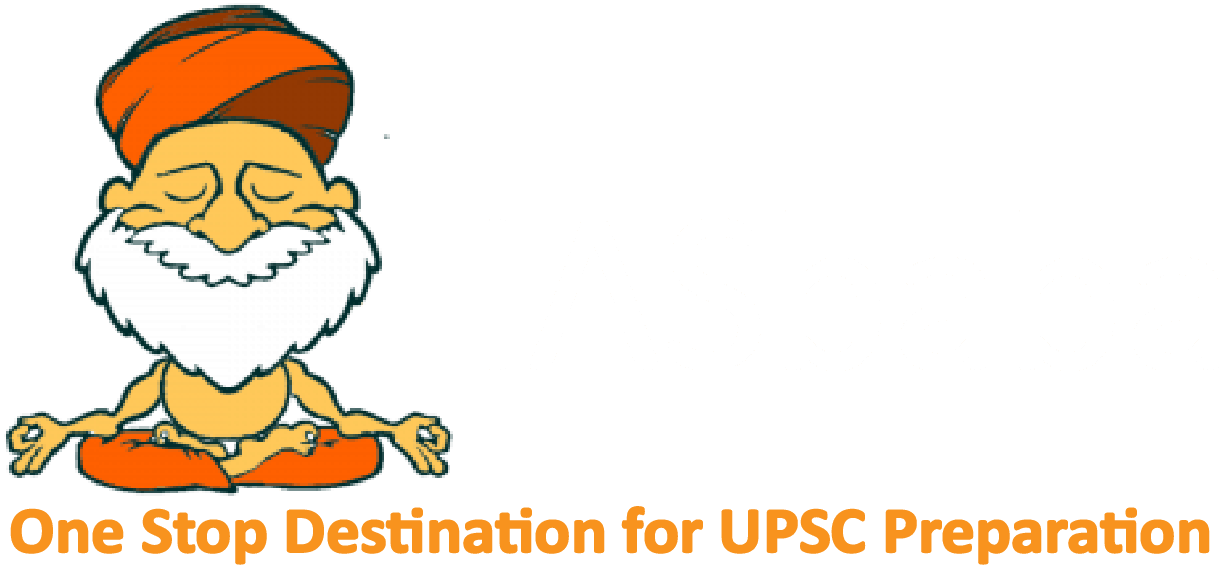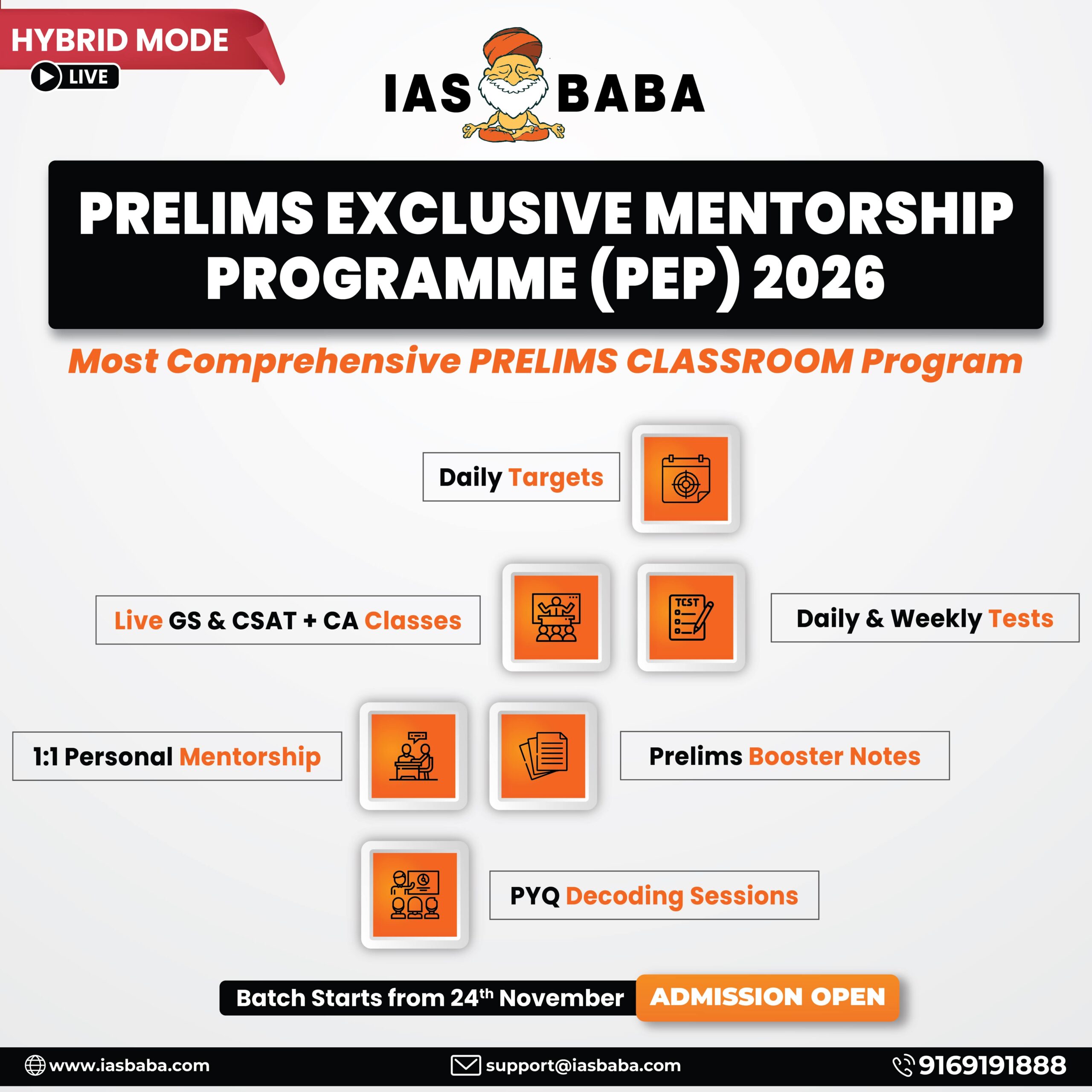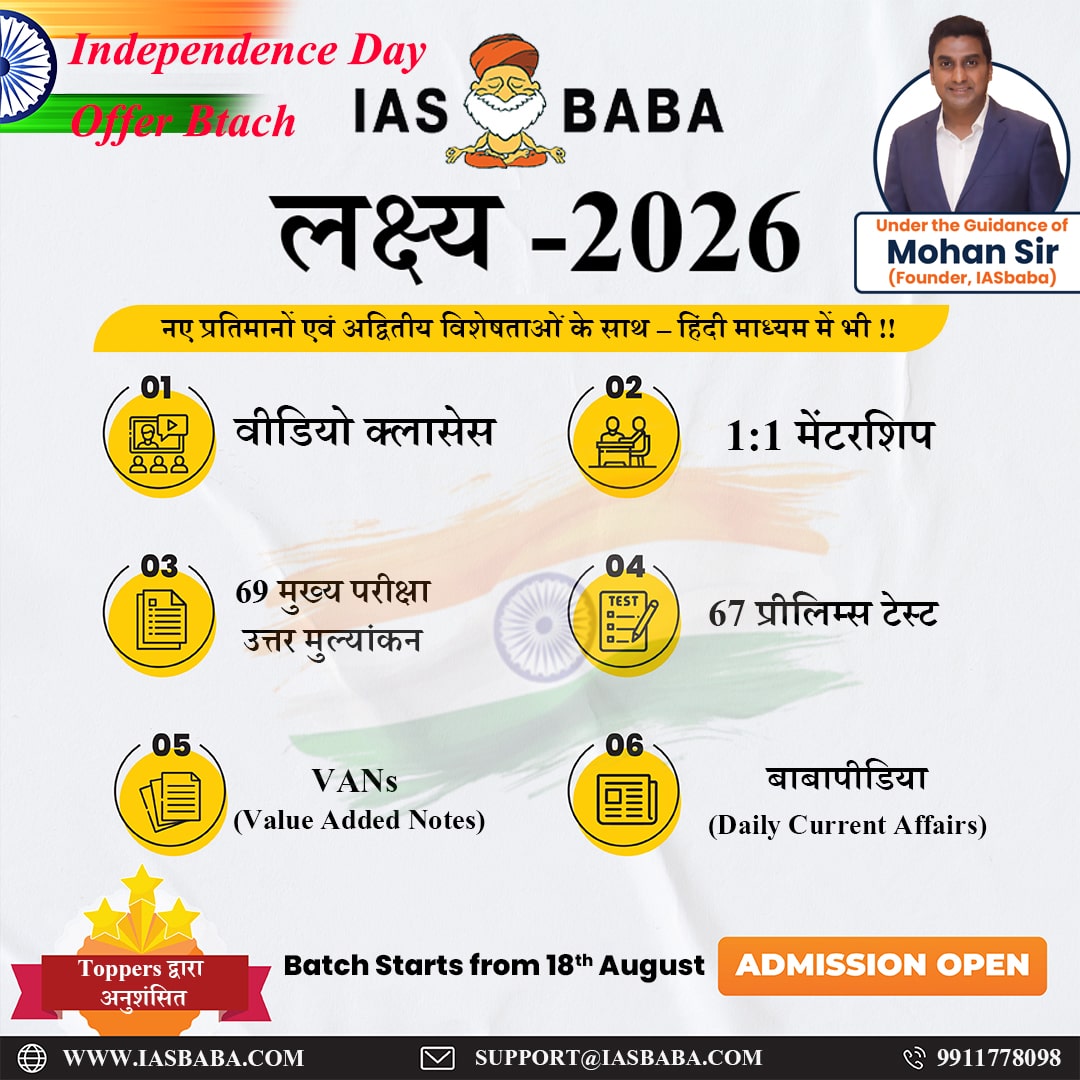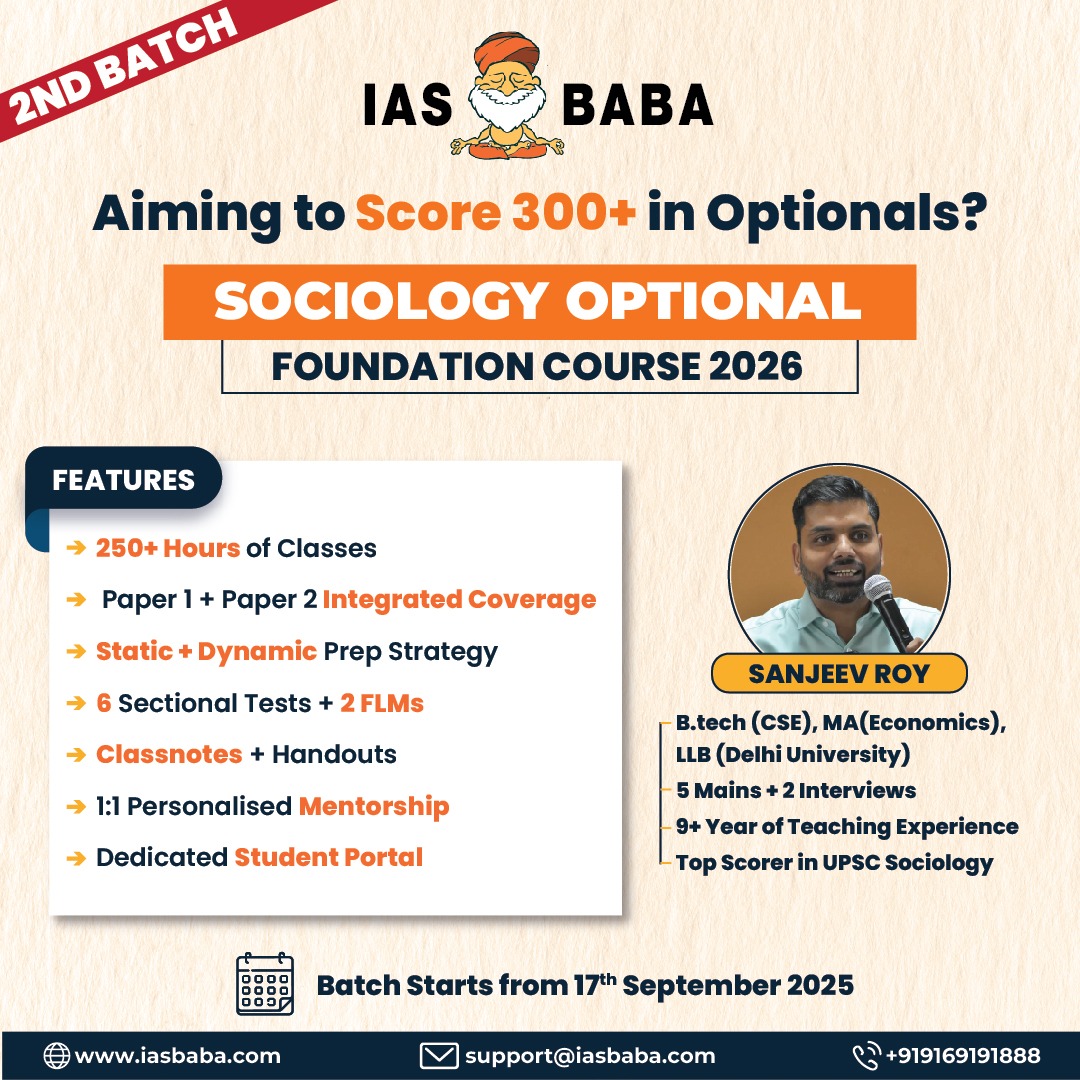IASbaba Daily Prelims Quiz
For Previous Daily Quiz (ARCHIVES) – CLICK HERE
The Current Affairs questions are based on sources like ‘The Hindu’, ‘Indian Express’ and ‘PIB’, which are very important sources for UPSC Prelims Exam. The questions are focused on both the concepts and facts. The topics covered here are generally different from what is being covered under ‘Daily Current Affairs/Daily News Analysis (DNA) and Daily Static Quiz’ to avoid duplication. The questions would be published from Monday to Saturday before 2 PM. One should not spend more than 10 minutes on this initiative.
Gear up and Make the Best Use of this initiative.
Do remember that, “the difference between Ordinary and EXTRA-Ordinary is PRACTICE!!”
Important Note:
- Don’t forget to post your marks in the comment section. Also, let us know if you enjoyed today’s test 🙂
- After completing the 5 questions, click on ‘View Questions’ to check your score, time taken, and solutions.
Test-summary
0 of 5 questions completed
Questions:
- 1
- 2
- 3
- 4
- 5
Information
To view Solutions, follow these instructions:
- Click on – ‘Start Test’ button
- Solve Questions
- Click on ‘Test Summary’ button
- Click on ‘Finish Test’ button
- Now click on ‘View Questions’ button – here you will see solutions and links.
You have already completed the test before. Hence you can not start it again.
Test is loading...
You must sign in or sign up to start the test.
You have to finish following test, to start this test:
Results
0 of 5 questions answered correctly
Your time:
Time has elapsed
You have scored 0 points out of 0 points, (0)
| Average score |
|
| Your score |
|
Categories
- Not categorized 0%
| Pos. | Name | Entered on | Points | Result |
|---|---|---|---|---|
| Table is loading | ||||
| No data available | ||||
- 1
- 2
- 3
- 4
- 5
- Answered
- Review
-
Question 1 of 5
1. Question
-
With reference to the Non-Aligned Movement (NAM), consider the following statements:
-
The Bandung Conference of 1955 laid the foundation for the principles that later guided the Non-Aligned Movement.
-
The first NAM Summit was held in Belgrade in 1961 under the leadership of Jawaharlal Nehru, Josip Broz Tito, and Gamal Abdel Nasser.
-
The Non-Aligned Movement was formally institutionalized as a treaty-based organization under the United Nations Charter in 1970.
Which of the above statement(s) is/are correct?
Correct
-
Solution (b).
Explanation:
-
- The Bandung Conference (1955) emphasized Afro–Asian solidarity and outlined principles such as mutual respect, non-aggression, and peaceful coexistence, which became the ideological foundation of NAM. Hence Statement 1 is Correct.
- Statement 2 is Correct: The first NAM Summit was held in Belgrade (1961) under the leadership of Nehru, Tito, and Nasser. Hence Statement 2 is Correct.
NAM is not a treaty-based or UN-affiliated organization; it functions as a political movement based on shared principles. Hence Statement 3 is Incorrect.
Incorrect
-
Solution (b).
Explanation:
-
- The Bandung Conference (1955) emphasized Afro–Asian solidarity and outlined principles such as mutual respect, non-aggression, and peaceful coexistence, which became the ideological foundation of NAM. Hence Statement 1 is Correct.
- Statement 2 is Correct: The first NAM Summit was held in Belgrade (1961) under the leadership of Nehru, Tito, and Nasser. Hence Statement 2 is Correct.
NAM is not a treaty-based or UN-affiliated organization; it functions as a political movement based on shared principles. Hence Statement 3 is Incorrect.
-
-
Question 2 of 5
2. Question
-
With reference to the Scheduled Tribes and Other Traditional Forest Dwellers (Recognition of Forest Rights) Act, 2006 (FRA), consider the following statements:
-
The Act recognizes the right of forest-dwelling communities to protect, regenerate, and conserve community forest resources traditionally managed by them.
-
Under the FRA, the claims of forest rights by Other Traditional Forest Dwellers (OTFDs) can be recognized only if they have resided in the forest land for at least 75 years prior to 2005.
-
The Forest Rights Committees (FRCs) are constituted by the State Government at the district level to process claims and maintain records under the Act.
Which of the above statement(s) is/are incorrect?
Correct
-
Solution (a)
Explanation:
- Section 3(1)(i) of the FRA, 2006 explicitly recognizes Community Forest Resource (CFR) rights, which empower Gram Sabhas to protect, regenerate, conserve, and manage forest resources for sustainable use. Hence Statement 1 is Correct
- As per Section 2(o) of the Act, Other Traditional Forest Dwellers (OTFDs) must have resided in forest land for at least three generations (one generation = 25 years) prior to 13 December 2005 — i.e., 75 years. Hence Statement 2 is Correct
- Forest Rights Committees (FRCs) are not constituted by the State Government; they are elected by the Gram Sabha at the village level under Rule 3 of the Forest Rights Rules, 2008 to process claims and submit them to the Sub-Divisional Level Committee (SDLC). Hence Statement 3 is Incorrect
Incorrect
-
Solution (a)
Explanation:
- Section 3(1)(i) of the FRA, 2006 explicitly recognizes Community Forest Resource (CFR) rights, which empower Gram Sabhas to protect, regenerate, conserve, and manage forest resources for sustainable use. Hence Statement 1 is Correct
- As per Section 2(o) of the Act, Other Traditional Forest Dwellers (OTFDs) must have resided in forest land for at least three generations (one generation = 25 years) prior to 13 December 2005 — i.e., 75 years. Hence Statement 2 is Correct
- Forest Rights Committees (FRCs) are not constituted by the State Government; they are elected by the Gram Sabha at the village level under Rule 3 of the Forest Rights Rules, 2008 to process claims and submit them to the Sub-Divisional Level Committee (SDLC). Hence Statement 3 is Incorrect
-
-
Question 3 of 5
3. Question
- The Carbon Border Adjustment Mechanism (CBAM), recently implemented by the European Union, primarily aims to —
Correct
-
Solution (c).
Explanation:
The EU’s CBAM is a carbon-pricing mechanism designed to prevent carbon leakage by imposing a carbon cost on imports such as steel, cement, fertilizers, aluminium, and electricity from countries with weaker emission standards. It ensures a level playing field for EU industries adhering to strict emission norms. Hence Option (a) is Correct.
Conceptual Insight:
CBAM is part of the EU Green Deal and Fit for 55 package; it aims to extend the EU’s climate objectives globally by incentivizing low-carbon production practices.Incorrect
-
Solution (c).
Explanation:
The EU’s CBAM is a carbon-pricing mechanism designed to prevent carbon leakage by imposing a carbon cost on imports such as steel, cement, fertilizers, aluminium, and electricity from countries with weaker emission standards. It ensures a level playing field for EU industries adhering to strict emission norms. Hence Option (a) is Correct.
Conceptual Insight:
CBAM is part of the EU Green Deal and Fit for 55 package; it aims to extend the EU’s climate objectives globally by incentivizing low-carbon production practices. -
Question 4 of 5
4. Question
- In the context of traditional sports in India, Kambala refers to —
Correct
-
Solution (d).
Explanation:
Kambala is a traditional buffalo racing festival practiced mainly in the Tulu Nadu region of coastal Karnataka, particularly in Dakshina Kannada and Udupi districts. It is conducted on muddy, waterlogged paddy fields during the post-harvest season between November and March. Hence Option (a) is Correct.
Conceptual Insight:
Kambala is recognized as a traditional rural sport under the Prevention of Cruelty to Animals (Karnataka Amendment) Act, 2017, ensuring its continuation with humane practices.Incorrect
-
Solution (d).
Explanation:
Kambala is a traditional buffalo racing festival practiced mainly in the Tulu Nadu region of coastal Karnataka, particularly in Dakshina Kannada and Udupi districts. It is conducted on muddy, waterlogged paddy fields during the post-harvest season between November and March. Hence Option (a) is Correct.
Conceptual Insight:
Kambala is recognized as a traditional rural sport under the Prevention of Cruelty to Animals (Karnataka Amendment) Act, 2017, ensuring its continuation with humane practices. -
Question 5 of 5
5. Question
-
With reference to the National Green Tribunal (NGT), consider the following statements:
-
The NGT was established under the provisions of the National Green Tribunal Act, 2010 for effective and expeditious disposal of cases relating to environmental protection and conservation of forests.
-
The Tribunal is bound by the procedure laid down under the Code of Civil Procedure, 1908 and cannot evolve its own procedures for disposal of cases.
Which of the above statement(s) is/are incorrect?
Correct
-
Solution (b).
Explanation:
- The NGT Act, 2010 established the Tribunal to handle cases relating to environmental protection, forest conservation, and enforcement of legal rights related to the environment. Hence Statement 1 is Correct.
- Under Section 19 of the Act, the NGT is not bound by the Code of Civil Procedure, 1908; it follows principles of natural justice and may regulate its own procedure. Hence Statement 2 is Incorrect.
Incorrect
-
Solution (b).
Explanation:
- The NGT Act, 2010 established the Tribunal to handle cases relating to environmental protection, forest conservation, and enforcement of legal rights related to the environment. Hence Statement 1 is Correct.
- Under Section 19 of the Act, the NGT is not bound by the Code of Civil Procedure, 1908; it follows principles of natural justice and may regulate its own procedure. Hence Statement 2 is Incorrect.
-
- Current Affairs Quiz, IAS Daily Current Affairs Quiz, IAS UPSC Current Affairs Quiz, IAS UPSC Prelims Quiz, IASbaba's Current Affairs Prelims Quiz, IASbaba's Daily Quiz, IASbaba's UPSC Quiz, Prelims Current Affairs Quiz, UPSC Current Affairs Quiz, UPSC Current Affairs Quiz IASbaba, UPSC Daily Current Affair Quiz, UPSC IAS Daily Quiz













